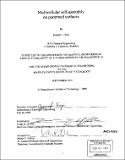Multicellular self-assembly on patterned surfaces
Author(s)
Fujii, Jennifer T. (Jennifer Tomiko), 1972-
DownloadFull printable version (11.47Mb)
Other Contributors
Massachusetts Institute of Technology. Dept. of Chemical Engineering.
Advisor
Linda G. Griffith.
Terms of use
Metadata
Show full item recordAbstract
Controlling the spatial distribution of cells in two and three dimensions may be important in the design of advanced tissue engineering scaffolds and other biomedical applications. In this thesis, the concept of biophysical sorting was applied as a method to control the spatial distribution of cells. This approach relies on a self-assembly process that is dependent, in part, on the intrinsic adhesivity of cells. A model system was developed using a simple patterning technique to prepare surfaces with alternating regions that supported variable cell response. First, the influence of certain biophysical parameters that may govern multicellular assembly of a single cell type on patterned surfaces was quantitatively investigated. For surfaces patterned with small features that allow cells to sample surrounding regions through membrane protrusions, it was found that a dynamic equilibrium distribution of cells correlated with differen~es in cell-substratum adhesion strength. The approach to that distribution, however, could be kinetically limited by the inability of the individual cells to sample adjacent areas of the patterned surface. This kinetic limitation was studied on surfaces with increasingly large feature sizes, and found that a simple diffusion model of migration may not completely describe the present system. Other effects such as contact inhibited motility and an induction time for migration may also influence multicellular assembly. The potential of multicellular assembly to simultaneously control the distribution of two cell types was also investigated. First, the multicellular assembly of each cell type was studied in isolation. Co-culture experiments indicated that, in addition to the factors that govern the assembly of a single cell type, sorting of two cell types depended on cell density. Images of high cell density co-cultures suggest that incomplete biophysical separation was achieved.
Description
Thesis (Ph.D.)--Massachusetts Institute of Technology, Dept. of Chemical Engineering, 2000. Includes bibliographical references.
Date issued
2000Department
Massachusetts Institute of Technology. Department of Chemical EngineeringPublisher
Massachusetts Institute of Technology
Keywords
Chemical Engineering.